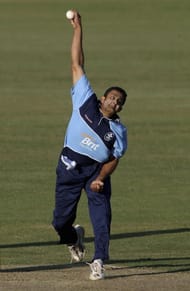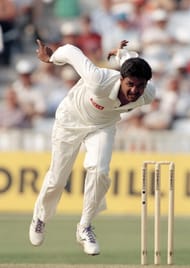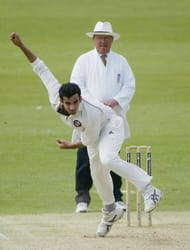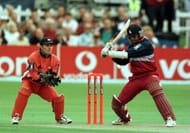Just a couple of days ago, discarded Indian opener Gautam Gambhir was signed by Essex for the remainder of their season.
With the Indian team scheduled to tour South Africa in a few months, the left-hander will be keen to re-work certain aspects of his game and score some runs in the process in order to come back into the reckoning.
This isn’t the first time that an Indian cricketer has chosen to ply his trade in English county cricket. The timeless legends Sunil Gavaskar, Mohammad Azharuddin, Dilip Vengsarkar, Kapil Dev, Bishan Singh Bedi and the late Tiger Pataudi – all of them perfected their batting skills on the seaming, swinging, bouncy pitches or polished their guiles with the red cherry.
With the advent of Twenty20 cricket, however, basic cricketing sense seems to have disappeared from the minds of the new generation of players.
India, unfortunately, bore the brunt of this illogical attitude on their 2011 tour to England and Australia.
A spell in county cricket not only helps you to refine your core strengths, but also gives you the much-needed break away from the rigours of international cricket.
More often than not, it is this stint that helps one become a better all-round cricketer.
Murali Kartik, after being left out of the national side for a long period, is a regular player for Surrey, while Harbhajan Singh seems to be back at his nagging best after turning out for Essex.
Here are some of those players who benefited from spending quality time in county cricket:
5. Mohammad Azharuddin (Derbyshire)
The former Indian captain also enjoyed a short stint with English county side Derbyshire in the early nineties. Known for his graceful, fluid batting style, Azhar, like many other illustrious batsmen before him, chose to ply his trade in England during the off-season.
In his own inimitable style, the wristy Hyderabadi hit a magnificent 205 against Durham, an innings characterized by several of his trademark flicks and immaculate footwork against the spinners.
England player David Graveney, whose left-arm spin troubled the rest of the Derbyshire batsmen, came in for severe punishment by the Indian batsman.
Although Derbyshire lost the game, Azhar’s innings stood out for its sheer grace and effortless placement of the ball into the gaps.
He left the county in rather acrimonious circumstances. The duration of his stay also provided him some insights into his own game, and he shone on subsequent tours to both England and South Africa – in fact, it was his experience of playing on seaming tracks in England that enabled him to be among the few performers in the Cape Town Test against South Africa in 1997.
4. Anil Kumble (Surrey, Leicester and Northamptonshire)
India’s champion leg-spinner turned out for Northamptonshire in 1995 after Indian captain Mohammad Azharuddin contacted former England player Allan Lamb and requested him to sign his compatriot as a replacement for West Indies pacer Curtly Ambrose.
Kumble accepted without hesitation and did not even discuss the terms of the contract. His chief aim was to bring more variety into his bowling, and to get a feel of the pitches in England. India were to tour that country in 1996.
During the one-day games, he stuck to a lower trajectory and bowled quick, while for the Championship games, he would bowl slower than normal; notably sending down six googlies to a left-hander. In that golden season, Kumble picked up 105 wickets – 64 of those for Northants.
However, on the England tour in 1996, Kumble struggled on lively pitches, bagging only five wickets in the three-Test series. Four years later, he turned out for Leicestershire, playing for them in the PPP Healthcare County Championship.
Later, Kumble was signed by Surrey for the 2006 season, and took 8/100 in a seven-wicket defeat of his old county Northants before a shoulder injury ruled him out for the remainder of the season.
He returned to international cricket in some style – he bagged all ten wickets against Pakistan in the famous Test at Delhi in 1999, helped by his experience of playing for Northamptonshire.
After his stint with Leicestershire, Kumble displayed his grit by removing Brian Lara in the Antigua Test of 2002, a game made more notable by the fact that he bowled with a broken jaw.
He eventually retired from international cricket in 2008, and he credits his first season with Northants in 1995 as a vital learning experience in terms of variety – his googly acquired potency and troubled international batsmen for a long time.
3. Javagal Srinath (Gloucestershire, Leicestershire and Durham)
India’s premier fast bowler of the nineties joined Gloucester for the 1995 season, following some valuable advice from West Indian great Courtney Walsh.
The latter would serve as a mentor to Srinath, instructing him on the finer points of bowling fast and consistently. He took 87 wickets for Gloucester that season, with a fiery spell of 9/76 against Glamorgan becoming his best effort.
On the subsequent tour of England in 1996, Srinath and Prasad formed a formidable fast-bowling pair as the two delivered a series of fine performances, with Prasad outshining Srinath in the wickets tally.
His ability to move the ball off the seam, complemented by swing and reverse-swing, kept batsmen hopping at the crease most of the time. It translated into a magnificent spell of 6/21 against the Proteas at Ahmedabad, shutting them out for 105.
He also reduced Pakistan to 26/6 in 1999 with a ferocious display of pace bowling that stunned the rest of the world, though India ended up losing that game.
Srinath also represented Leicestershire and Durham in the early 2000s with varying degrees of success, and his stints with both counties enabled him to shoulder the workload of being India’s premier pacer until the 2003 World Cup final, after which he announced his retirement.
He did extremely well on the faster pitches in England, South Africa and New Zealand; in fact, due to his experience of playing county cricket, about half of his 236 Test wickets came from tours abroad.
2. Zaheer Khan (Worcestershire, Surrey)
The powerful left-arm fast bowler has attributed his recent successes at the international level to his tenure with English county side Worcestershire in 2006.
Zaheer’s tryst with county cricket began in 2004 when he was signed up by Surrey to replace the injured Pakistani off-spinner Saqlain Mushtaq. He had to leave mid-way through the season on national duty for the Asia Cup, and so did not get the kind of exposure he needed.
In 2006, the 28-year -old, who had been dropped from the side due to injuries and loss of form, was chosen to represent Worcestershire, replacing injured Pakistan speedster Shoaib Akhtar.
In his first game against Somerset, the left-armer took ten wickets but Worcester lost the match. Against Essex in June that year, Zaheer grabbed nine wickets in the first innings, and had the wicket-keeper not dropped an edge by the last man, he would have been the first bowler to take all ten for the county.
His 78 wickets from 16 games at Worcestershire helped him to regain his place for the 2007 England tour, where he aided India in winning a Test series on English soil for the first time in 21 years. He also became the joint highest wicket-taker in the 2011 World Cup, helping India to their second title in the event after 28 years.
Zaheer fully credits his stint at Worcestershire for a resurgence in his injury-prone career. He understood the nuances of the game, bowling on different kinds of wickets, and above all, it instilled in him a sense of professionalism and a great understanding of various cultures.
Youngsters such as Ishant Sharma and Bhuvneshwar Kumar would do well to take Zak’s advice.
1. Rahul Dravid (Kent)
Arguably one of India’s greatest ever batsmen to have played at No. 3 in Test cricket, Rahul Dravid also benefited well from the time he spent at Kent in 2000. A man who was keenly aware of his travails in the ODI arena, the soft-spoken future India captain had just come off a successful World Cup campaign in 1999, where he scored 461 runs.
At Canterbury, Dravid achieved recognition for both his calm approach and the capacity to stay out in the middle for long periods of time while scoring runs by the bucketful. His off-side play also improved during the limited-overs segment of the County Championship, and he was at his immaculate best in the longer version as well.
Hampshire’s Australian leg-spinner Shane Warne, who had named Dravid as the one batsman against whom he had the psychological advantage, was made to eat his words as the Indian stalwart hammered 137 and 73 not out in order to steer Kent to a six-wicket win over their opponents.
It was yet another example of Dravid’s complete mastery of English conditions since his 1996 Test debut at Lord’s. Since his county stint, Dravid went on to achieve greater heights in both forms of cricket, scoring heavily on India’s tours abroad. New Zealand, Australia, South Africa, England, West Indies – you name it, Dravid scored runs in it.
On India’s disastrous 2011 tour to England, the veteran batsman was the lone bright spot in the Test series, scoring 461 runs, finishing second behind Kevin Pietersen. Again, his county experience was a factor in his stellar performances as he was the only one who proved capable of handling the short-pitched deliveries well.
In the lightning-quick world of Twenty20, you may never see purity of technique or the gritty mindset all the time. But a visit to an English county, as these greats have shown, is more beneficial in the long run. Is the BCCI listening?
Brand-new app in a brand-new avatar! Download Cric Rocket for fast cricket scores, rocket flicks, super notifications and much more!




